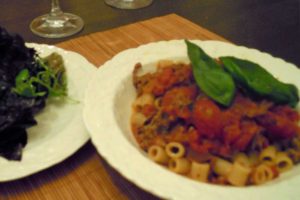Stracotto di Cucuzza
Cucuzza is the long, pale-green squash so beloved by Sicilians for its slightly sweet cream-colored flesh. Technically cucuzza is a gourd rather than a squash. In the United States, it’s typically found in late summer and most prominently in August. In Sicily, I’ve found it in the markets as early as late May. It is high in fiber and in vitamin C. It grow on vines, which must be trellised so the fruit hangs above the ground. The vines can grow up to two feet in one day and the fruit as much as ten inches a day, often reaching a length of three feet at maturity. It can grow straight or with a curve, with the diameter ranging from around an inch to as large as three inches. Choose smaller-diameter cucuzza for culinary purposes. The larger-diameter, more mature fruit develop a large spongy interior of seeds, which must be scooped out before cooking.
The first time I cooked it I made the terrible mistake of not peeling the thin green, innocent-looking skin. The result: after cooking, the skin turned as hard as plastic. The fruits are easily peeled with a vegetable peeler. Cucuzza are as versatile as any squash, but I prefer this stracotto, which means stew, made with onions, tomatoes, and fresh herbs. It’s fortuitous that these ingredients are at their prime concurrently in August. In Palermo’s markets, you find piles and piles of cucuzza (as seen in the accompanying photo taken in the Ballaró Market) , and I believe the quality is higher than those I’ve bought in America, though our crop is perfectly fine. Most Sicilian-Americans who maintain vegetable gardens grow it, as my grandfather did. It’s not readily available in the U.S., but I’ve noticed that many farmer’s markets, particularly those stands run by Italians, feature it, in August. Some specialty food shops often carry it as well, and this year even my local supermarket in Manhattan stocked it. Though I’ve never used the service, I’ve discovered that cucuzza can be ordered on Wegmans website in season.
If you are unable to find it, you can substitute zucchini or other summer squash. However, the taste and texture will be quite different.
Unlike zucchini, Cucuzza maintains a firmer crunchier texture after cooking. This stracotto makes a wonderful side dish, but for a whole vegetarian meal, it can be served over pasta, rice, or polenta.
Click here to print or download the recipe.



